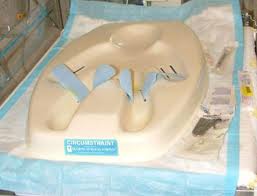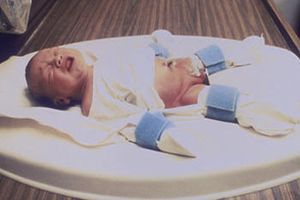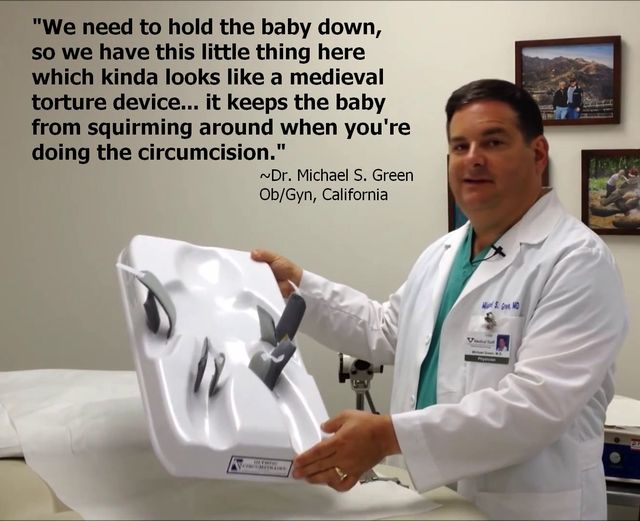Circumstraint
A Circumstraint is an immobilization device for infant non-therapeutic circumcision. Circumstraint stands for Circumcision Restraint.
Contents
Description
The Circumstraint is made of molded plastic cut in a rectangular form with indentations for the body of the newborn infant boy to fit into. It is equipped with straps to totally immobilize the infant to prevent any movement whatsoever and effectively prevent the "flight or fight" response to danger.
History
Raymond C. Creelman applied for a patent for this device on 14 December 1953. The patent was granted on 19 June 1956. The patent expired on 19 June 1973.[1]
The device was formerly manufactured by Olympic in Washington. It is now manufactured by Natus Medical and retails for $654.00.[2] The manufacturer claims that more than 11,000 have been sold.
Why the Circumstraint is needed
When the Circumstraint was introduced medical doctors absurdly and bizarrely believed that newborn infants could not feel pain.[3] Circumcisions were carried out without any kind of pain relief, analgesia, or sedation. The surgical amputation of the highly sensitive foreskin was done with a wide awake non-anesthetized infant, who would do his best to escape from the intense pain and trauma of amputative surgery, so a restraint device was needed so that no greater physical injury was done to the infant than the intended injury of foreskin amputation.
It is now known that infant boys feel pain fully and more intensely than adults.[4] It is dangerous to give newborn infants general anesthesia, so the only possible pain relief is local nerve block, which is now recommended if a circumcision is to be done. These are of doubtful efficacy because of multiple nerve pathways in the penis, so baby boys still kick and scream, making the Circumstraint still necessary if a circumcision is to be done. Parents are reminded that infant circumcision is an unnecessary, non-therapeutic surgical amputation that does not cure or prevent disease and does permanently harm infant boys by loss of the protective, immunological, sexual, and sensory functions of his foreskin.[5]
Video
Quotes
From the manufacturer:
| “ | Struggling infant In less than 30 seconds a nurse can immobilize a struggling infant...[6] |
| “ | Escape He's held safely and securely without danger of escape.[6] |
| “ | Perfectedly presenting Circumstraint's comfortable contoured shape positions the infant, hips elevated, perfectly presenting the genitalia.[6] |
Medieval torture device
Commentary
| “ | The Body Keeps the Score When fighting or running does not take care of the threat, we activate the last resort — the reptilian brain, the ultimate emergency system. This system is most likely to engage when we are physically immobilized, as when we are pinned down by an attacker or when a child has no escape from a terrifying caregiver. Collapse and disengagement are controlled by the DVC, an evolutionarily ancient part of the parasympathetic nervous system that is associated with digestive symptoms like diarrhea or nausea. It also slows down the heart and induces shallow breathing. Once this system takes over, other people, and we ourselves, cease to matter. Awareness is shut down, and we may no longer even register physical pain. – Bessel van der Kolk[7] |
See also
External links
 Brown B (2016).
Brown B (2016). Circumstraint Patent and Origin
, Saving Our Sons. Retrieved 28 October 2022.
References
- ↑

Surgical operating table for small infants
, Google. Retrieved 28 October 2022. - ↑

Natus Medical 50100 — Circumstraint Infant
, Central Infusion Alliance. Retrieved 28 October 2022. - ↑
 Cope DK. Neonatal pain: the evolution of an idea.. The American Association of Anesthesiologists Newsletter. September 1998; Retrieved 28 October 2022.
Cope DK. Neonatal pain: the evolution of an idea.. The American Association of Anesthesiologists Newsletter. September 1998; Retrieved 28 October 2022.
- ↑
 Anand KJS, Hickey PR, et al. Pain and its effects in the human neonate and fetus. N Engl J Med. 19 November 1987; 317(21): 1321-9. PMID. DOI. Retrieved 28 October 2022.
Anand KJS, Hickey PR, et al. Pain and its effects in the human neonate and fetus. N Engl J Med. 19 November 1987; 317(21): 1321-9. PMID. DOI. Retrieved 28 October 2022.
- ↑
 Uberoi M, Abdulcadir J, Ohl DA, et al. Potentially under-recognized late-stage physical and psychosexual complications of non-therapeutic neonatal penile circumcision: a qualitative and quantitative analysis of self-reports from an online community forum. Int J Impot Res. 23 October 2022; PMID. DOI. Retrieved 28 October 2022.
Uberoi M, Abdulcadir J, Ohl DA, et al. Potentially under-recognized late-stage physical and psychosexual complications of non-therapeutic neonatal penile circumcision: a qualitative and quantitative analysis of self-reports from an online community forum. Int J Impot Res. 23 October 2022; PMID. DOI. Retrieved 28 October 2022.
- ↑ a b c Olympic Circumstraint — Infant Immobilizer
- ↑
 van der Kolk, Bessel (2014):
van der Kolk, Bessel (2014): Chapter Five
, in: The Body Keeps the Score. Penguin Books. P. 85. ISBN 978-0-14-312774-1. Retrieved 17 July 2023.


